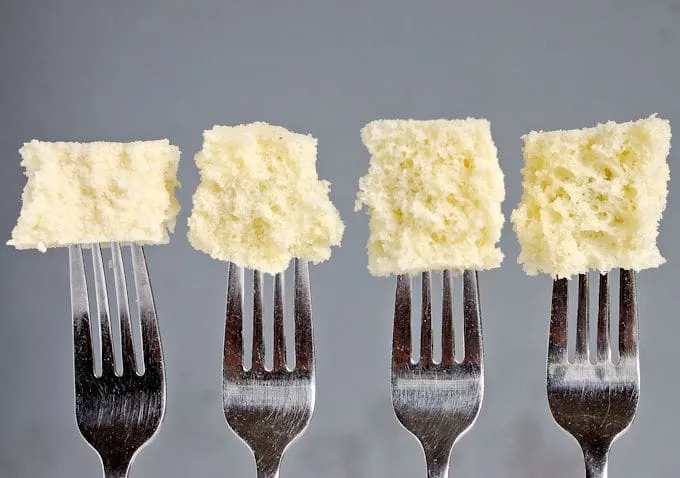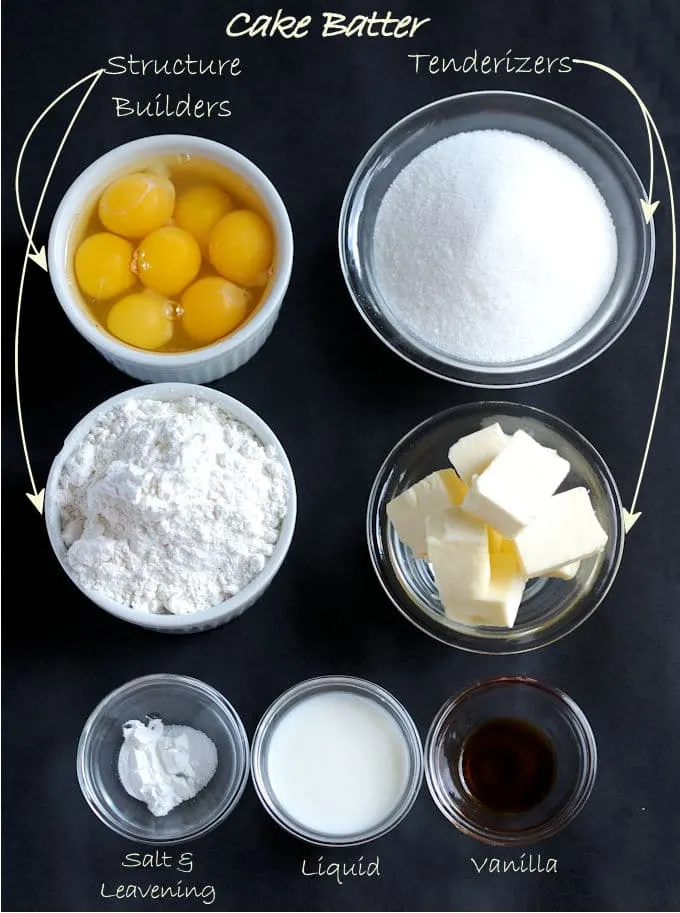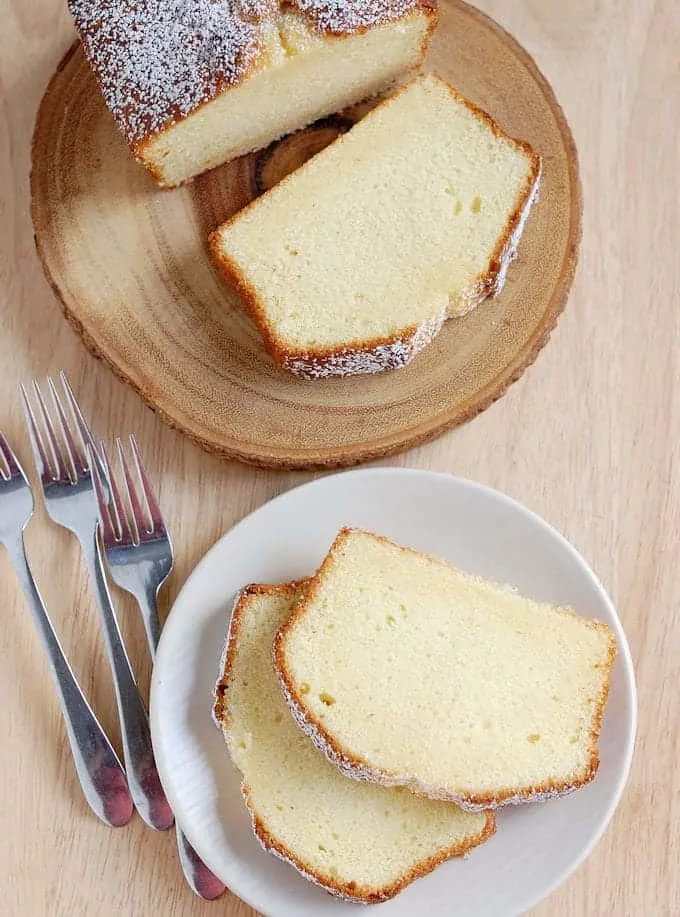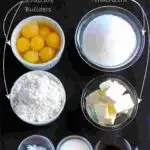How to create the best Cake Recipes
In this article we’ll learn how to create a great cake recipe using the Baker’s Formula.
The information in this article is the culmination of all our Cake Batter classes, but can also stand alone. If you’d like to follow the classes in order visit the Baking School/Science of Cake Batter page.

Use the Baker’s Formula for making the best cakes
To make a perfectly moist and soft cake you’ll first need to understand the concept of the baker’s formula.
A successful cake recipe balances the ingredients that strengthen the cake structure (flour and eggs) with the ingredients that weaken and tenderize the cake structure (sugar and fat).
The Baker’s Formula is used to calculate the proper percentage of each ingredient for a successful recipe. The flour in the recipe is designated at 100% and all the other ingredients are designated relative to the flour. This is a very important point, so keep it in mind as we get deeper into it.

Lean Cakes vs. High Ratio Cakes
About Lean Cakes:
A pound cake recipe made with equal weights of flour, sugar, butter and eggs is a so-called “lean cake”. A “lean cake” has a very simple 1:1 formula balancing the structure-builders with the tenderizers.
The only liquid in the original recipe comes from the eggs (egg whites are 90% water).
About High Ratio Cakes:
While a lean cake is made with equal proportions of flour and sugar, a high ratio cake has a higher proportion of sugar to flour.
In order for a high ratio cake to have good structure we need to adjust some of the other ingredients to keep the cake formula balanced.
Liquid brings together the structure builders and the tenderizers in the batter. The liquid activates the gluten and swells the starch in the flour. The liquid also dissolves the sugar and helps disperse the fat throughout the batter and, of course, provides moisture.
If we use cake flour, with it’s finely ground starch that absorbs extra moisture, we can change the Baker’s Formula to allow for more liquid.
We can also use an emulsifier in the batter to help bind the liquid and fat in the batter. This allows for even more liquid in the recipe, and thus more sugar since you need liquid to dissolve sugar.
A cake made with cake flour and an emulsifying agent can now be higher than 1:1 (sugar:flour) without compromising the structure.

Adjust the Baker’s Percentages for A Better Pound Cake
I used the original quatre quarts pound cake recipe as the basis for all the cake batter classes because the simple 1:1:1:1 ratio makes it very easy to measure changes. So that is the recipe I will use to show you how to use the baker’s formula to improve a cake recipe.
The first step was to lighten the crumb a tiny bit, so I added a little baking powder to the recipe. A pinch of salt and a teaspoon of real vanilla extract were added to enhance the flavor.
Now that the cake was lighter I wanted to sweeten things up a bit. The Baker’s Formula for a high ratio cake allows for up to about 140% of the weight of sugar to flour. I found in my testing that I like pound cake with a ratio of 125% sugar to 100% flour. With this in mind I increased the sugar in the recipe from 8 oz to 10 oz.
I also wanted to add a little extra liquid for moistness, so I needed an emulsifier in the batter. Vegetable shortening will act as an emulsifier, but I prefer an all-butter cake for the unparalleled flavor.
Instead of using shortening in the batter, I used a few extra egg yolks because yolks are great emulsifiers and also add a little extra fat and flavor to the batter. I changed the 8 oz of eggs in the recipe to 3 whole eggs and 4 extra yolks.
Now that we have cake flour and emulsifying eggs yolks in the recipe we can add a little more liquid for additional moisture. I added whole milk as the liquid for a basic pound cake recipe.
The revised recipe makes the perfect melt-in-your-mouth buttery pound cake.
Adjust Baker’s Formula for A Lighter Vanilla Layer Cake
Of course the Baker’s Formula is not only useful for perfecting pound cake recipes. We can continue to test the limits of the structure builders and tenderizers to create a whole world of cake recipes.
I’ll give you another example. As I said, the perfect pound cake should have a dense, buttery texture that doesn’t need any icing at all. But a Vanilla Layer Cake is meant to be filled and iced with frosting. So a great Vanilla Layer Cake should be a little lighter and softer than a pound cake.
As a comparison, let’s look at the Baker’s Percentages for my Pound Cake Recipe vs. my Vanilla Butter Cake Recipe:
| Pound Cake | ||
| Flour | -8 oz | 100% |
| Fat | -9 oz | 112% |
| Sugar | -10 oz | 125% |
| Eggs | -8 oz | 106% |
| Liquid | -7.5 oz (w/eggs) |
| Vanilla Cake | ||
| Flour | -9 oz | 100% |
| Fat | -10.6 oz | 116% |
| Sugar | -12 oz | 133% |
| Eggs | -6.6 oz | 73% |
| Liqui | -12 oz (w/eggs) |
Ok, that’s a lot of information. But lets look at the percentages. (Remember: all percentages are relative to the weight of flour in the recipe.)
By just looking at the percentages you can guess that the vanilla cake will be a little more tender (more sugar and fat), a little sweeter (more sugar) and a little more moist (more liquid) than the pound cake.
The vanilla cake recipe also has more leavening and I whip the whites before adding them to the batter. So the vanilla cake also has a more open and light crumb than the pound cake.
Whew!!! So, all those small changes to the basic formula created a lighter, sweeter and softer cake. That’s just what I want for a cake that will be filled and iced with buttercream.
The takeaway here is that every cake recipe in the universe is some variation on this formula. The type of fat or liquid can change, additional ingredients can be added, but it’s always about the balance between structure and softness.
It’s the variations that create the myriad of cake recipes that we can invent and perfect.


Eileen,
I have appreciated reading through your cake series. I bake often and I try to develop my own recipes and it’s been fairly successful for the most part. Once I realized that I needed to adjust liquids, flour, sugar and leaveners for elevation, I started having consistent success. However, I am in the middle of developing a Twinkie recipe and it’s stumping me. My issue is finding a recipe that will keep the inside tender enough to move out of the way of the cream filling while staying intact. Annoying, right? I’ve tried manipulating a reverse creaming recipe by folding in whipped egg whites in at the end but it still seems a little dense after cooling. I’m using organic, European slow churn style butter and I’ve tried using buttermilk and yogurt thinking the acid might help with leavening and tenderness. I’m just not getting the results I need.
The cakes are of course quite tender when warm but once they cool, that darn cake doesn’t want to accommodate the filling. All my testers have requested more cream filling and I happen to agree. I’ve developed a SMBC/marshmallow combo that is pretty tasty! My next plan was to work with a chiffon and sub invert sugar syrup for some of the granulated sugar to keep it moist and more tender. I am not using cake flour because I’m trying to source locally. I am using AP flour and I fully understand it has shortcomings for what I’m attempting to do. It’s just one of the rules of some of the farmers markets I want to attend so I really don’t have a choice. I have to source what I can locally and in Montana, we happen to grow wheat!
Any thoughts you have would be appreciated. I’m having fun experimenting but it would be nice to finally have a recipe that I can consistently reproduce and even convert to chocolate etc… I realize it’s a high bar but I’m creative and willing to keep trying!
Thank you for your lessons, they have been giving me all kinds of new ideas to try!
Hi Holly, glad you’re enjoying the series. I think moving towards a chiffon style cake is a great idea. It was a more spongy, open crumb. How you tried using a combination of ap flour and cornstarch to soften the crumb? Use 3/4 cup of ap flour plus 2 Tablespoons of corn starch for each cup of flour in the recipe. Good luck Post a photo if you crack the code.
Please forgive me for writing a book in your comment section. I absolutely love your posts that get into the science of baking. I’m a HUGE nerd and am consistently unsatisfied with nearly every cake I bake. I’ve spent the last few weeks reading up on all this stuff. I’m putting spreadsheets together to collect recipes and calculate numbers for each. Many of the rules are simple enough, but there are a few things that aren’t clear to me and I was wondering if you’d be willing to provide some insight?
First, how do you determine how much liquid a cake needs? I know that there must be enough liquid to dissolve all of the sugar, but many recipes have MUCH more than that. In my list of 36 white cakes, the baker’s percentage of liquid ranges from 100% to 213%. Comparing liquid to sugar, they range from 94% to 167%. Your own white cake recipe comes in at 147% and 109%, respectively.
Second, for layer-type cakes (not pound cakes), is there a guideline of how much fat should be used, compared to flour? Again, I see huge variations here between recipes ranging from 35% to 90% Your white cake recipe is actually the chart-topper at 90%. Does having too much fat in a cake make it crumbly? I’ve made the 35% cake before, and it was probably the worst, driest cake ever to come out of my oven. So obviously there is such a thing as too little fat.
It’s really interesting to me how these recipes are just all over the place, ratio-wise. One other trend I noticed is that the majority of recipes exceed 100% of sugar to flour. Modern tastes must be for sweeter, high-ratio cakes. Apparently I dislike the firmer texture of “eggy” cakes where they outweigh the fat. I am actually excited to try your white cake recipe, because it seems to fit my preference for a sweeter (sugar is 135% of flour), less eggy (fat is 115% of eggs) cake. Although the numbers seem to indicate a higher probability of collapse due to too many tenderizing ingredients and not enough structure.
Please don’t apologize, Michael, I appreciate your passion! First to address the fact that modern cakes mostly have more sugar than flour. As I noted in my recipe testing, I personally found a slightly higher percent of sugar to flour improves the cake texture and flavor. So I agree with you there. Instead of addressing each of the other questions I refer you back to the last line of this post, “It’s the variations that create the myriad of cake recipes that we can invent and perfect.” As I always say “baking is an art and a science.” The cake formula explains the science of the how the ingredients work, but the art of baking is figuring out how to manipulate those ingredients and the technique to get the best results. The cake formula is not a set of “rules” really so much as a way of explaining how a cakes texture is affected by the variation of ingredients. You can push the limits with any of the ingredients to get the texture you’re after. In fact, in my white cake post I acknowledge that the cake will “settle” as it comes out of the oven because it is a tender cake. I’m fine with that because I like the final texture of the cake. There is no such thing as “correct” or “perfect” cake recipe. That’s where the “art” (and fun!) of baking comes in.
Eileen,
Is it possible to make a lemon pound cake (that has the same taste and texture as Starbucks lemon loaf) by replacing the vanilla with lemon oil and/or lemon juice
in your Perfect Pound Cake Recipe?
Hi Ruth. I’ve never tasted Starbucks lemon loaf so I can’t say for sure what the texture is, etc. But you can certainly turn my pound cake recipe into a lemon cake by adding lemon flavor. I like to use fresh lemon zest (that’s where the oil is) and a little lemon extract. The juice of the lemon has more acidity than lemon flavor. But I do like to use the juice to make either a syrup or a glaze for the cake to give it a puckery finish.
Hello Ellen,
I found this place on Pinterest and have been enjoying this very much. I was wondering about banana cake. Would you use the reverse mixing method or the regular method for a banana cake? Also how about the egg white method for this as well?
Thank You
It depends if the banana cake uses butter or oil as the fat in the recipe. I’d really have to see the recipe to say. Do you have a recipe already or are you looking to create one?
Hello Eileen,
I came to your site to comment on the BreadBakers event but got lost in the lovely post on the basics of baking cake. For the last one hour, I have been intently reading the posts on baking. Your posts are so helpful, giving technical aspects of baking. Can’t thank you enough, Eileen.
Oh, thanks so much Namita! You have no idea how happy that makes me. Sometimes we spend all the time researching and writing this stuff and don’t know if it’s helping! You’ve made my day!